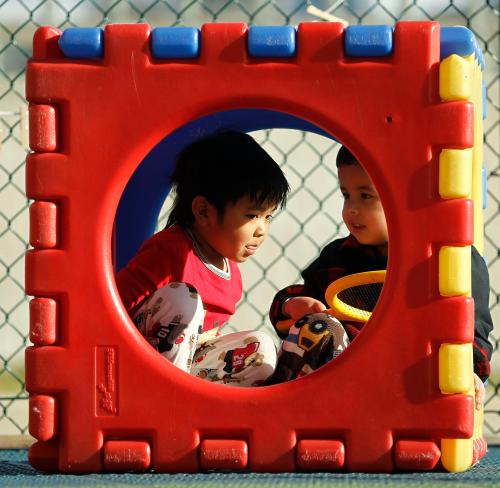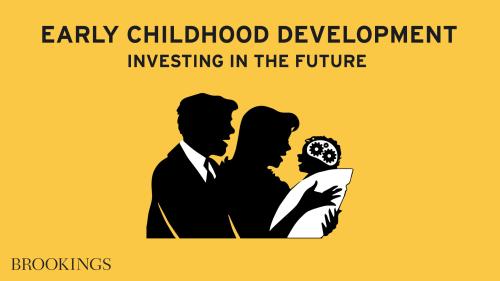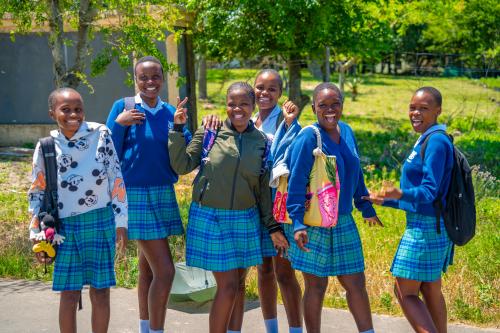This post originally appeared on the Stanford Social Innovation Review (SSIR) as part of the Preparing Today’s Youth for Tomorrow’s World series produced in partnership with SSIR and CUE.
We have heard the argument before: Low-income children suffer from an achievement gap that has plagued them since before the term was coined in 1975. To remedy these inequities, many well-meaning policymakers and educators tell us, we must return to the basics. They claim that because some poor children come from environments that foster toxic stress, and because they do not have rich cognitive stimulation, we must adopt a laser focus on the basics, using the 6 hours of each school day to drill and grill them on vocabulary learning, math, reading, and writing—and spending little time on recess, the arts, or playful learning. Teachers of low-income children have become what Erika Christakis called “carnival barkers,”reading scripted materials to kindergarteners who sit passively in rows of desks or cluster sleepily on rugs. This will set them on a better path to the future, the argument goes. It is the only way.
Implicitly, the message is clear: Low-income children learn differently than middle-income children. They have no time for and cannot afford “extras” like drama or painting or sometimes even recess. Yet just because you are born into a poor family does not mean that you should be “trained and not educated,” as Arthur Jensen argued in the 1960s.
No Child Left Behind (NCLB) was one sweeping policy initiative that adopted a drill and grill strategy to close the achievement gap. And it did not work. The latest international PISA scores include children who spent their entire academic career under NCLB, and who sadly have remained in the middle of the pack on reading, math, and science outcomes. Yet the pressure to offer children strictly academic offerings continues. According to a recent article by Daphna Bassok and colleagues, 80 percent of kindergarten teachers say that their children should be proficient readers—up from 50 percent just two decades ago. They spend less time on art (down 16 percent since 1998) and more time on test preparation—up 29 percent. A similar 2009 study by the Alliance for Childhood surveyed 254 kindergarten teachers in New York and Los Angeles and found that 79 percent in New York and 82 percent in Los Angeles reported spending time every day on test preparation!
It is absolutely clear that some preschool programs have had positive impacts on underserved children. The success of programs in Boston and New Jersey have shown that it is possible to offer high quality preschool education at scale and at reasonable cost. A recent report from Bassok and Scott Latham finds that low-income children are catching up on kindergarten entrance exams. Compared with 1998, the achievement gaps between white and black students in 2010 decreased by 16 percent–and not because white students’ performance declined.
The question before us, however, is whether these new results are due to the draconian practices that offer a razor sharp focus on the basics delivered at school, particularly for low-income children. Did our pedagogical focus on “drill and kill” at the expense of activities focused on creativity and critical thinking have any cost for low-income children, or are those activities largely dispensable?
The scientific research indicates that the shift in focus has, indeed, come at a cost. While reading and math are critically important, they do not emerge in a vacuum. Reading, for example, is parasitic on language. Thus, a child who has poor language skills but can chirp out that the letter b sounds like “buh” gains little in the translation from print to meaning. A child does not acquire a rich vocabulary from lists of unrelated words, but rather from complex conversations that are themselves founded on social relationships. How many of those old SAT words that you memorized could you still use intelligently? The oft-referred-to “soft skills” of collaboration and communication are in fact foundational for the “hard skills” of reading, writing, and so on.
In fact, a New York Times commentary on recent new research by Sean Reardon, Jane Waldfogel, and Bassok in August suggested that access to preschools could not in and of itself explain the narrowing in the achievement gap between rich and poor kids. “It may be changes in children’s homes that have mattered most,” they wrote. Since 1998, education advocates have focused on telling parents that it is good to talk with, sing to, and read to babies—yes, even babies. Campaigns like Vroom and Too Small to Fail are reaching millions of children and their families by highlighting the importance of early brain and language development and providing parents with the tools to engage their young children from birth. Vroom, for example, texts low income parents regularly about fun activities they can do with their kids.
These findings make it clear that poor children do not start out with different brains that demand a drill-and-kill approach to learning. Quite the contrary. Social and cognitive experiences in school, as well as outside it, shape all children’s brain growth and create different propensities for exploring the world or learning language. Our challenge is to offer a high-quality mental diet, be it in and out of school, for all children. And that high quality comes from exposing children to a breadth of skills—skills that support basic learning, that help children grow up healthy today and fit into the workplace of tomorrow. Success is not merely about memorizing facts in an age where facts are readily available in devices in every child’s pocket.
Our book, Becoming Brilliant, offers a scientific case for the cognitive and social diet that all children need to be successful in the modern world. A rich banquet of six intertwined, measurable skills, supported by the science of learning, form the core of our dynamic learning model. Collaboration (working and playing well with others); communication (language, listening, writing); content (the “three Rs”— reading, ‘riting, and ‘rithmetic—and the ability to focus your attention, to be flexible when learning); critical thinking (sifting through the mountains of information that face us and selecting what we need for the problem at hand); creativity (putting information together in new ways), and confidence (grit, learning from failure)—these are the linchpins on which the model rests. And no, collaboration and creativity are not “extras,” only to be accessed by advantaged children who have strong content skills. They are the stuff from which we make whole people who can use the knowledge they receive to conquer new, never-before-encountered problems.
Learning the basics requires exposure to a panoply of experiences that foster the 6Cs all children need as they prepare to be future workers and citizens. Evolution prepared the human brain to develop in just this way. Poor kids learn just like rich kids and all the kids in between.
The Brookings Institution is committed to quality, independence, and impact.
We are supported by a diverse array of funders. In line with our values and policies, each Brookings publication represents the sole views of its author(s).









Commentary
Poor kids learn like rich kids and all the kids in between
November 2, 2016